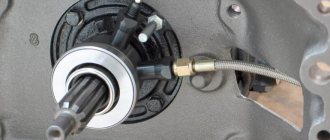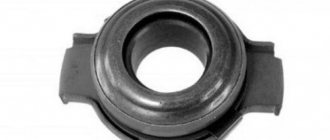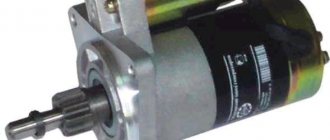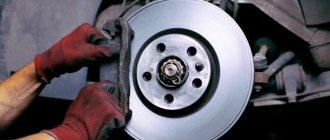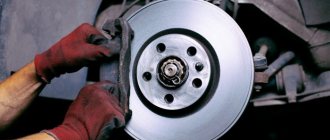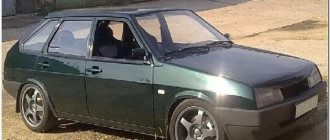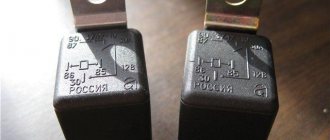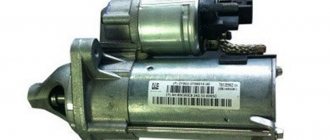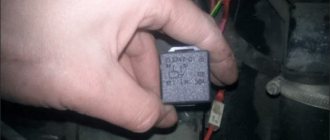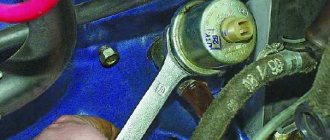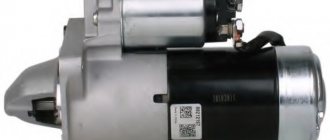If, when turning the key in the ignition switch, the starter simply clicks, but does not turn and, as a result, the engine cannot start, the reason here is quite simple and now we will deal with it in detail.
It's clear that when a car doesn't start right away, it annoys any motorist. The reasons are as follows: the contacts on the battery may simply become disconnected, and there may also be a malfunction in the starter. But an experienced driver, based on certain signs and clicks, will always be able to understand in which particular unit the malfunction occurred.
Starter device in a car
The starter, as an element of the car's structure, is not at all complex in its structure, but very important. If it is faulty, the car simply will not start or move. Without a properly working starter, starting the engine is impossible.
Car starter device
Globally, the starter itself is a small electric motor with a relay that turns it on and off, as well as a so-called bendix, which is responsible for rotating the flywheel of the engine itself. The entire system is located inside a housing made of metal.
How does a starter work?
If we consider the starter more generally, then inside it there are special “shoes” - magnetic cores that are the stator. There is also an “anchor” - a shaft with a steel core with special frames, which during operation of the device rotate around the magnetic poles and are connected to the collector, which in turn is connected to special “brushes”. The latter are both positive, connected to the battery, and negative, going to the so-called ground. There is also a special contact on the starter body, to which one of the battery terminals, the positive one, is connected during assembly.
This is what the starter armature looks like
On a note! For the starter to work, it needs current from the battery. But the starting current is not supplied constantly; it is required only when the engine starts. To ensure that the current does not flow constantly, a special “nickel” is used that closes the contacts.
There is a special connection on the “armature” shaft, where the bushing and bendix with gear are located, which can move along the axis. He goes to the flywheel, turns it and goes back. It is worth understanding that it does not move on its own: a special retractor relay helps it move.
Bendix starter
If we consider the operation of the starter step by step, it looks something like this:
- turning on the ignition and transmitting relay voltage;
- magnetization of the relay coil and movement of the core, which moves the bendix to the flywheel;
- closing the nickels on the electric motor and supplying the starting current to the armature;
- rotating the armature in a magnetic field and starting the starter.
Operation of a car starter
As soon as the engine starts, the current stops flowing to the relay, the nickels open, and the bendix returns to its primary position. Then the starter is not used until the next time the engine starts.
Starter relay repair
Repairing the starter relay seems to be a very troublesome and often hopeless task, so an easier option would be to simply buy a new one and replace it. This is due to the fact that, worrying about the reliability of their product, most manufacturers produce non-separable starter relays for both VAZ 2106 cars and other brands of cars. However, there are still models that are not difficult to disassemble and repair.
There are several main breakdowns that you may encounter while working with the starter relay of a VAZ 2106 car. The first is wear of the mechanical wire, the second is the burning of nickels, and the third is a short circuit. Each of these failures can be determined by disassembling the starter relay.
You can also use a special tester to check the serviceability of the starter relay, which does a good job of determining a short circuit in the circuit.
If, after disassembling this part, you find scratches or burrs on it, they need to be removed using sandpaper. Parts that have significant wear can be corrected using gaskets, but this does not always bring the desired result. Sometimes it will be more effective to replace them with new ones. Damaged insulation should also be replaced with a new one. Collectors with worn or loose plates cannot be repaired and must be replaced.
If there are noticeable breaks or damage to the thread, then it is worth cutting a new one or using so-called screws.
If there are faults in the excitation windings, you should disassemble the housing, remove the screws securing the tips and terminals. The coils must be thoroughly dried and impregnated with insulating varnish. Contacts that have oxidized must be cleaned, and those that have been welded must be replaced with new ones.
The bushings on the starter of a VAZ 2106 car are changed if they have significant wear or scuff marks are found on them. To determine the wear of these same bushings, you need to measure the roller clearance. If it is more than 0.2 mm, then the bushings are worn out and must be replaced.
When carrying out all the above work, one should not forget about safety precautions and under no circumstances violate them.
A starter is an element of a vehicle - an electric motor that has 4 poles. He starts the engine in the car. As for the principle of its operation, it is based on the fact that it transmits the initial stroke to the engine crankshaft. Thanks to the 4 brushes of this device, the level of power and torque increases. Of course, if the starter is faulty, the engine cannot be started.
How to understand that the problem is in the starter?
But if suddenly your car stops starting, how can you understand that the problem is in the starter? After all, there can be a huge number of reasons for the malfunction of the iron horse. In fact, it is simple to understand that the reason lies precisely in the starter. When you try to start the car when you turn the key, the engine shows no signs of life, and from under the hood you hear a buzzing, clicking, ringing, grinding or absolute silence. This symptomatology is typical for cases associated with malfunctions of both the starter itself and its control system.
Car starter diagnostics
Let's try to do a little diagnostics. First of all, we check whether the battery is charged. If the current supplied to the starter from the battery is not enough, then the mechanism simply will not turn, but in fact, everything is fine with the starter itself. Just need to charge the battery a little. And, of course, we check the voltage on the battery using a voltmeter: if its value is lower than 9V, then the battery requires recharging.
Checking the starter
It is also worth checking whether the battery terminals are in place and whether all main contacts are in order. Violation of the contact level in one place or another leads to the fact that the current for the starter is again insufficient, and it cannot perform its functions.
Articles on the topic
Car alarm repair
How to replace the alternator belt
How does the VAZ-2110 starter relay work?
When the current stops flowing through the coil, the armature is free in the core. The solenoid relay consists of a magnet with two windings, an armature, contacts and a return spring. The magnet consists of two coils: one retracting, the other holding. The first is connected to the control terminal and the electric motor, the second is connected to the control terminal and goes to the housing.
When the control contact is energized, magnetic induction is induced in the coil, creating a magnetic field that causes the armature to compress the return spring. At the same time, it rotates the bendix, which connects the battery to the starter. The retracting winding is energized “+” when the contacts are closed, the current stops flowing through the coil, but the armature remains inside under the influence of the field of the holding coil.
When the engine starts and the power is turned off, the return spring moves the armature to its original place - the contacts are open, the bendix is disengaged.
The starter does not turn: what could be the problem and how to solve it?
Thus, if everything is in order with the battery and the quality of the contact, then the problem really lies in the breakdown of the starter. Let's take a closer look at the different types of faults.
Contacts
So, we have already said above about lost contacts. But there is another important point: the contacts could not come off, but oxidize. In this case, the starter tries to spin, but does it very poorly and eventually stops altogether. The fact is that the contacts on the terminals, relays or ground have oxidized, and the film formed by oxidation simply violated the quality of the contact. Solving the problem in this case is simple: after checking all the connections, you need to find those that “do not come into contact” and simply clean them with sandpaper or use a special cleaning agent.
The starter contacts are loose
Control circuit
If, when you turn the key, the starter does not show any signs of life at all, then perhaps the reason lies in a malfunction of the control circuit, that is, the solenoid relay does not receive current from the battery, and the starter does not start. This is a fairly rare breakdown, but it still occurs.
Starter control circuit
You can find out whether this problem is to blame by using a multimeter: check if there is voltage on the solenoid relay wire when the key is turned. If it is missing, be sure to check both the relay and the ignition switch and the condition of the wires. If, when power is supplied to the terminal directly from the battery, the starter starts to work, then the reason definitely lies in the control circuit.
Checking the starter with a multimeter
Advice! Don't forget to check the contact group fuses.
Solenoid relay
By the way, the starter may not show any signs of life at all even if the solenoid relay breaks down. We check whether there is voltage on the thin wire of the relay when turning the key. If it is there, but the starter is “deaf and dumb,” then the reason definitely lies in the relay. In this case, it needs to be replaced.
Starter solenoid relay
Methods for emergency engine starting if the starter does not work
If the starter does not show any signs of life - it does not click or make any sounds at all - you can start the engine directly. Not the best method, but suitable in an emergency situation when you urgently need to start the car.
Let's consider the algorithm of actions for starting the engine directly using the example of the popular Lada "Ten" (VAZ-2110). You need:
- Put the car in "handbrake" and set the gear to neutral.
- Turn the key to turn on the ignition.
- Open the hood - further work will take place in the engine compartment.
- Remove the air filter from the driver's seat to gain access to the starter contacts.
- Disconnect the chip that goes to the contact group.
- Using a metal object, you need to short-circuit the starter terminals. For example, a screwdriver or a piece of wire is suitable for this.
If other components are working properly and the battery is sufficiently charged, these simple manipulations will start the car. Replace the air filter and the chip leading to the contact group.
It's funny that after starting directly, the engine, as a rule, will continue to be started simply with the ignition key. But this does not mean that the problem is solved. The breakdown cannot be done anywhere and you need to identify it and fix it.
Signs of a faulty starter
To make it easier to navigate possible starter breakdowns and their diagnosis, we have compiled a small summary table to help you.
Signs of a faulty starter
Table. Symptoms of starter failures and their types: let’s figure out what needs checking.
| Symptom | Where to look and what it could be |
| Buzzing noise when turning the starter | The overrunning clutch needs checking. |
| Grinding and ringing | The bendix teeth and flywheel are worn out. |
| Does not rotate or rotates with difficulty when hot | Rotor bushings or bearings are damaged. |
| Characteristic clicks | Possible wear of the brushes, breakdown of the rotor winding, location of the magnets. |
| Complete absence of signs of life | Solenoid relay, control circuit, fuses require replacement/diagnosis. |
| Attempts to turn, but the starter doesn’t really turn and then stops turning altogether | Oxidized/lost contacts lead to loss of current and the battery charge level is low. |
If the diagnostics helped to identify the problem, then you need to start fixing it. As practice shows, most often the starter does not turn because of the brushes - they wear out. Now more about the repair.
Other causes of starter failure
The reasons listed above are not the only ones. There is also a short list of problems that indicate a faulty starter. These include:
• brush wear;
• winding short circuit;
• breakdown of the bendix fork;
• the return spring has moved out of place;
• the magnets installed on the starter have come unstuck.
• bendix teeth are worn out, etc.
In this case, a slow rotation of the crankshaft is observed. This happens because the oil in the engine is too thick, or the battery is discharged.
There are situations when the starter does not work when the engine is hot, but after it cools down it begins to function normally. In this case, the problem lies in the wrong size bushings. Perhaps they are smaller than they should be. As they heat up, the holes inside them become wider and the shaft jams. After cooling, everything returns to normal.
Replacing starter brushes: step-by-step instructions with photos
Let's see how you can replace the starter brushes with new ones yourself, if the need arises. Regardless of the car model, the process will always be approximately the same. For you - step-by-step instructions with photographs.
Step 1. First you need to unscrew the nut securing the brush assembly from the relay bolt.
Unscrewing the nut securing the brush assembly
Starter relay bolt
Step 2. Next, remove the brush assembly output contact from the relay bolt. This is a kind of cap plate with a hole in the middle.
Removing the brush assembly output contact
Step 3. The next step requires unscrewing the starter tie bolts, two in number.
Unscrewing the starter bolts
Step 4. Next you need to remove the motor from the housing.
Removing the motor from the housing
Step 5. Then you need to remove the so-called anchor along with the brush assembly.
Removing the armature with brush assembly
Step 6. Next, you need to unscrew the screws that secure the rear cap, and then remove the cap itself.
Unscrewing the screws securing the rear cap
Removing the rear cap
Step 7. After this, you need to remove the retaining ring from the back of the “anchor”.
Removing the retaining ring
Step 8. Next, the back cover from the armature also needs to be removed - after removing the retaining ring, this is not difficult to do.
Removing the starter rear cover
Step 9. All that remains is to remove the old brush assembly.
Removing the old brush assembly
Step 10. Now you can put the starter back together, but using a new brush assembly. You need to take it out of the package and put it in place of the old one.
Installing a new brush assembly
Step 11. All that remains is to assemble the starter by repeating steps 9 to 1 in reverse order.
Reassembling the starter in reverse order
Video - Replacing starter brushes
Element Role
All VAZ cars, including model 2109, have a standard engine starting system, which is based on an electric starter. Here's what you need to know about him.
- A starter is a small electric motor that is connected to the flywheel of the motor via a coupling (Bendix) for a short period of time to start the rotation of the flywheel.
- Despite its small dimensions, the starter passes through itself enormous currents.
- If the starter circuit were closed directly in the ignition switch, then not a single component of the system would be able to withstand such current loads. As a result, they would burn out.
- Therefore, for these purposes, the starter is connected remotely to the battery via a relay. Its contacts are designed for high currents.
- The starter operates briefly and must be turned off after the engine starts. Otherwise, its active destruction will begin due to the influence of motor power.
- Relyushka performs these tasks perfectly. Actually, it is precisely to ensure the functioning of the system and protection against current, timely shutdown of the starter, a retractor relay is included in the design.
Element diagram
Replacing the Bendix starter: step-by-step instructions with photos
Like the brushes, you can also replace the Bendix with your own hands without much difficulty. This section provides step-by-step photo instructions for replacing the Bendix starter. As in the previous case, it is quite universal.
Step 1: Start by unscrewing the brush assembly nut from the relay bolt.
Unscrewing the brush assembly nut from the relay bolt
Step 2. Then you need to remove the contact of the brush assembly output from the relay bolt, which was discussed above.
Removing the brush assembly output contact
Step 3. Then you need to unscrew the tension screws that secure the traction relay to the mask. There are three of them and they are all located nearby.
Unscrewing the clamping screws
Step 4. Next you need to pull the relay out of its seat.
Removing the relay from its seat
Step 5. Only after this can you unscrew the coupling bolts of the starter itself as in the instructions above in step 3 and remove the motor from the housing.
Unscrewing the starter coupling bolts Removing the motor from the housing
Step 6. The next step is to remove the relay core.
Removing the Relay Core
Step 7. Next you need to remove the gearbox from the housing. You are almost there.
Removing the gearbox from the housing
Step 8. You need to remove the fork from the gearbox that secures the bendix.
Removing the fork that fixes the bendix
Starter fork removed
Step 9. Then you need to knock the retaining ring off the gearbox shaft. To do this you will need a hammer and chisel.
Removing the retaining ring from the gearbox shaft
Retaining ring removed
Step 10. All that remains is to remove the old damaged bendix and replace it with a new one.
Removing a damaged bendix
Step 11. At this stage, you should install the new bendix in its rightful place.
Installing a new Bendix
Step 12. Now you need to assemble the starter by repeating steps 9 to 1 in reverse order. The locking ring is clamped using pliers.
Reassembling the starter
Features of checking the performance of elements of the starting system of a car engine
After visual inspection of the condition of the starting system parts, they begin to dismantle the starter to test its components:
- It is possible to determine how worn out the brush assembly is only after disassembling the starter housing. Despite the long service life of the brushes, they still wear out. At the same time, their development on some starter models does not allow the traction relay to be activated. In this case, the clicks it makes will not be heard.
- Burning of the windings on the coils can be easily determined both visually and by the presence of a burning smell. Since it makes no sense to restore their functionality, you will have to replace the starter.
- It is possible to perform a traction stress test without its housing. To do this, you need to close the two large terminals on the relay using a screwdriver, being careful not to catch the housing elements. The presence of problems with the retractor will be signaled by the beginning of shaft rotation. Note that one of the unpleasant consequences of this is the burning of the relay contact groups. Since they contain a special protective coating to prevent damage, it is not recommended to clean carbon deposits from them. In this case, only a complete replacement of the traction rod is indicated.
In addition to the procedures described above, it is necessary to pay attention to the ignition switch by checking the voltage in it. Often contact is lost in this node due to the coating of the wires with an oxide film and the formation of corrosion areas. To do this, it is enough to clean them, solder them, or replace them.
When is the best time to contact the service?
If, when turning the key, a clear click is heard, but the starter does not rotate, then there may be a breakdown of the rotor or starter windings and, as a result, a short circuit. This is a fairly rare problem associated with damage to the integrity of the windings. In this case, they can short-circuit both to the body and to each other. Here you will need the help of an auto electrician to solve the problem.
Why doesn't the starter turn?
A malfunction such as magnets peeling off can also show the same symptoms - which, by the way, is also very rare. And here, too, you need the help of a specialist. In principle, it is possible to correct the situation on your own, but to put the magnet in place, you need special glue.
Peeling off the magnets on the starter
Problems of an electrical nature, when you also need the help of a specialist, also include “glitches” of the immobilizer and alarm system. We need both systems to prevent criminals from stealing a car. And when the systems are active, they prevent the starter from receiving power and prevent the car from starting. And if there is something wrong with the security systems, they do not turn off and do not allow the starter to receive current. Here you should not solve the problem on your own - entrust the health of the iron horse to specialists.
The relay clicks, but the car does not start, how to start the car?
It seems like such a small unit, but it could be the reason why the car won’t start . But if you have a VAZ 2121 or any other VAZ with a manual transmission, then there is an excellent way out of the situation - just take and start the car from the pushrod. To do this, you need to turn the key, as you usually turn it when you want to start the car.
Then find several people and the whole crowd needs to push the car and continue to push it until the speed becomes more or less normal - about 5 km/h or more. At this moment you need to squeeze the clutch, engage 2nd gear and release the clutch, the car will jerk and should start, you need to give the gas at the moment when the car tries to start. If the car stalls, you need to repeat these steps. If it doesn’t stall, then you can drive on without stopping.
And you have to drive carefully so that the car doesn’t stall at a traffic light, and of course, you don’t have to turn off the engine yourself. If there is no one around to ask to push the car, then you need to look for a hill nearby and push the car yourself up to this hill and drive off it. When the car starts to roll down the hill, you can also turn the ignition key and engage second gear and release the clutch.
In general, the car will start this way without a starter and without a battery..
Video advice is a useful way to get out of a situation where the starter clicks but does not turn:
I bridge the connection with a screwdriver, everything is fine with half a turn...sometimes it also starts with the key...but it’s 1/50...I thought the contacts in the lock were not...intact, I decided to change them anyway...it didn’t help...where is something missing...the circuit on the starter relay is fine, no oxides ...It's annoying(((...what else to check?
Prevention
The disease is much easier to prevent than to treat. And in the case of the starter, this idea also remains relevant. If you carry out prevention in time, you can avoid most of the problems above.
Starter operating rules
- Don't just turn on the starter . It is not intended for long-term operation; it should not be kept in working condition for too long - the device may overheat.
- Watch to see if over time the starter begins to spin weaker than before , and if there are any suspicious noises. Appeared - it’s better to think about visiting the service or try to figure out the suspicious behavior of the element yourself.
- Don't forget to do preventive maintenance: regularly remove and clean the starter, even if it shows no signs of malfunction.
